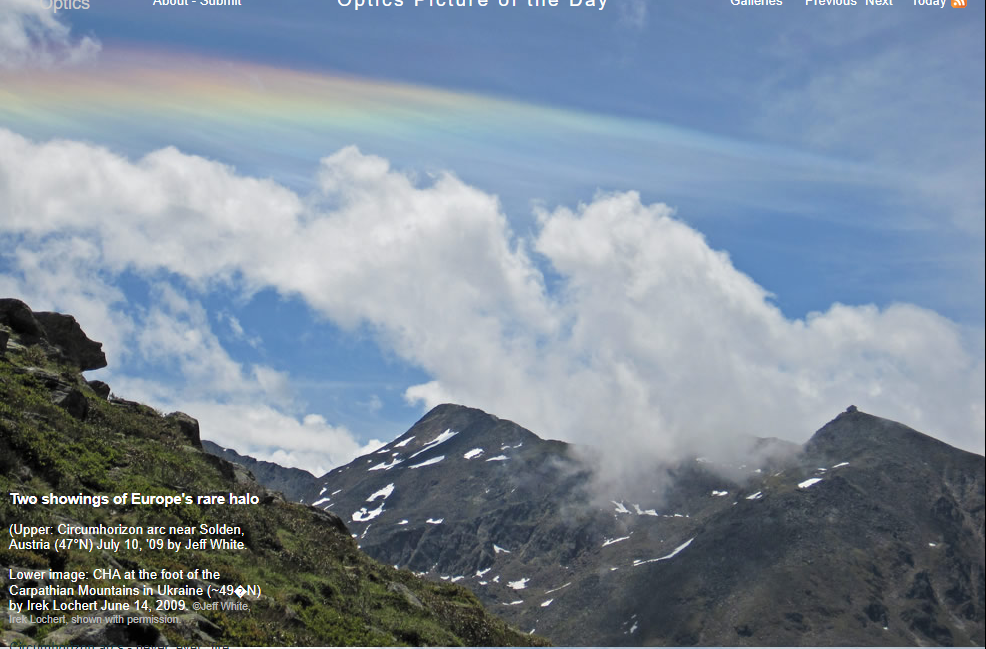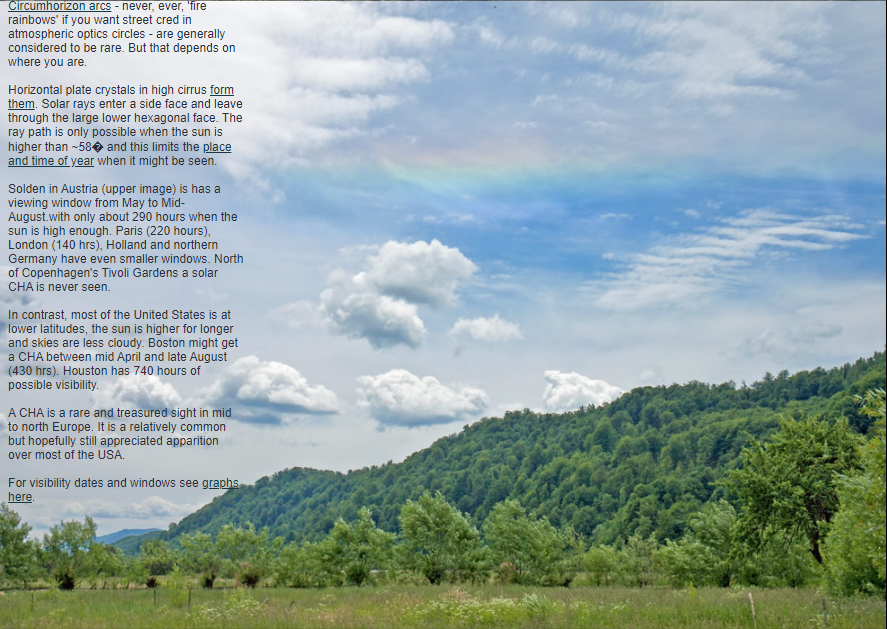Europe's Rare Halo
Europe's Rare Halo: A Spectacular Atmospheric Phenomenon
Have you ever witnessed the breathtaking beauty of a circumhorizon arc (CHA)? This rare atmospheric optical phenomenon, also known as a "fire rainbow," is a stunning display of vibrant colors that can be seen in certain parts of the world. However, its occurrence is limited to specific geographical locations and times of the year. In this article, we will delve into the details of Europe's rare halo and explore why it is a cherished sight in this region.
Understanding Circumhorizon Arcs
Circumhorizon arcs are formed by horizontal plate crystals in high cirrus clouds. When sunlight enters a side face of these hexagonal crystals and exits through the larger lower face, a unique ray path is created. However, this optical phenomenon can only be observed when the sun is positioned higher than approximately 58 degrees above the horizon. Consequently, the sighting of a CHA is restricted to specific latitudes and times of the year.
The Rarity of CHAs in Europe
In Europe, circumhorizon arcs are considered to be relatively rare compared to other parts of the world. The limited visibility of this phenomenon adds to its allure and makes it a treasured sight for those fortunate enough to witness it. The availability of viewing windows varies across different European cities, with some having shorter periods of visibility than others. Here are some examples:
- Solden in Austria offers a viewing window from May to mid-August, providing approximately 290 hours when the sun is high enough to create a CHA.
- Paris, London, Holland, and northern Germany have even smaller windows, with Paris offering around 220 hours, London with 140 hours, and Holland and northern Germany having similar or fewer opportunities.
- North of Copenhagen's Tivoli Gardens, a solar CHA is never seen.
Contrasting Views in the United States
In contrast to Europe, most parts of the United States are located at lower latitudes, resulting in longer periods when the sun is positioned higher in the sky. As a result, the sighting of a CHA is relatively more common in the United States compared to Europe. Here are a few examples:
- Boston experiences a longer viewing window, with potential sightings of CHAs occurring between mid-April and late August, providing approximately 430 hours of possible visibility.
- Houston, Texas, has an even greater opportunity to witness this phenomenon, with around 740 hours of potential visibility throughout the year.
Appreciating the Rare Sight
The rarity of circumhorizon arcs in mid to north Europe makes them a truly cherished sight for those living in these regions. The limited viewing windows and the unique atmospheric conditions required for their formation make these occurrences all the more special. Witnessing a CHA is a testament to the intricate beauty and complexity of our atmosphere, reminding us of the wonders that surround us.
In conclusion, Europe's rare halo, the circumhorizon arc, is an extraordinary atmospheric phenomenon that captivates those lucky enough to observe it. Its limited occurrence in certain parts of Europe adds to its mystique and makes it a highly sought-after sight. While more common in the United States due to geographical differences, the beauty and awe-inspiring nature of this optical phenomenon are universal. So keep your eyes on the sky, for you never know when you might catch a glimpse of Europe's rare halo, a spectacle that reminds us of the astonishing wonders present in our natural world.

Two showings of Europe's rare halo
(Upper: Circumhorizon arc near Solden, Austria (47°N) July 10, '09 by Jeff White.
Lower image: CHA at the foot of the Carpathian Mountains in Ukraine (~49�N) by Irek Lochert June 14, 2009. ©Jeff White, Irek Lochert, shown with permission.

Circumhorizon arcs - never, ever, 'fire rainbows' if you want street cred in atmospheric optics circles - are generally considered to be rare. But that depends on where you are.
Horizontal plate crystals in high cirrus form them. Solar rays enter a side face and leave through the large lower hexagonal face. The ray path is only possible when the sun is higher than ~58� and this limits the place and time of year when it might be seen.
Solden in Austria (upper image) is has a viewing window from May to Mid- August.with only about 290 hours when the sun is high enough. Paris (220 hours), London (140 hrs), Holland and northern Germany have even smaller windows. North of Copenhagen's Tivoli Gardens a solar CHA is never seen.
In contrast, most of the United States is at lower latitudes, the sun is higher for longer and skies are less cloudy. Boston might get a CHA between mid April and late August (430 hrs). Houston has 740 hours of possible visibility.
A CHA is a rare and treasured sight in mid to north Europe. It is a relatively common but hopefully still appreciated apparition over most of the USA.
For visibility dates and windows see graphs here.
Note: this article has been automatically converted from the old site and may not appear as intended. You can find the original article here.
Reference Atmospheric Optics
If you use any of the definitions, information, or data presented on Atmospheric Optics, please copy the link or reference below to properly credit us as the reference source. Thank you!
-
<a href="https://atoptics.co.uk/blog/europes-rare-halo/">Europe's Rare Halo</a>
-
"Europe's Rare Halo". Atmospheric Optics. Accessed on April 18, 2024. https://atoptics.co.uk/blog/europes-rare-halo/.
-
"Europe's Rare Halo". Atmospheric Optics, https://atoptics.co.uk/blog/europes-rare-halo/. Accessed 18 April, 2024
-
Europe's Rare Halo. Atmospheric Optics. Retrieved from https://atoptics.co.uk/blog/europes-rare-halo/.